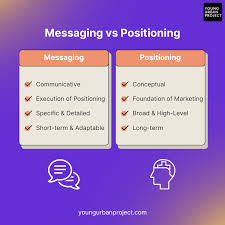In the world of marketing, positioning and messaging are two fundamental concepts that play a crucial role in how a brand communicates with its audience. While they are closely related and often used interchangeably, they serve distinct purposes and should be understood as separate elements of a marketing strategy. In this blog post, we will explore the differences between positioning and messaging, their importance, and how to effectively leverage both for successful marketing.
Table of Contents
- What is Positioning?
- What is Messaging?
- Key Differences Between Positioning and Messaging
- How to Develop Effective Positioning and Messaging
- Conclusion
1. What is Positioning?
Positioning refers to the process of defining how a brand or product is perceived in the minds of consumers relative to competitors. It involves identifying the unique value proposition that sets the brand apart and determining the target audience. Positioning answers the question: “What place do we want to occupy in the market?”
Key Elements of Positioning:
- Target Audience: Who are you trying to reach?
- Market Category: In which market or category does your brand compete?
- Unique Value Proposition: What makes your brand different and better than competitors?
- Competitive Landscape: How do you compare to other brands in the market?
Check Out: Types of Positioning In Marketing
2. What is Messaging?
Messaging refers to the specific language, tone, and content used to communicate a brand’s value proposition to its audience. It encompasses the key messages, taglines, and narratives that convey the brand’s identity and resonate with consumers. Messaging answers the question: “How do we communicate our positioning to our audience?”
Key Elements of Messaging:
- Core Messages: The main points you want to convey about your brand or product.
- Tone and Voice: The style in which you communicate (e.g., formal, casual, humorous).
- Supporting Messages: Additional details that reinforce the core messages, such as features, benefits, and testimonials.
Also Read: Positioning vs. Messaging: Differences
3. Key Differences Between Positioning and Messaging
4. How to Develop Effective Positioning and Messaging
Developing Positioning:
- Conduct Market Research: Understand your target audience, competitors, and market trends.
- Identify Unique Value: Determine what makes your brand or product unique and valuable.
- Define Your Positioning Statement: Create a clear and concise statement that encapsulates your positioning.
Please Read :
What is a Product Line?
What is Product Mix?
Developing Messaging:
- Craft Core Messages: Develop key messages that align with your positioning and resonate with your audience.
- Choose Tone and Voice: Decide on the style of communication that reflects your brand’s personality.
- Create Supporting Content: Develop additional materials (e.g., taglines, social media posts, website copy) that reinforce your core messages.
5. Conclusion
Positioning and messaging are both essential components of a successful marketing strategy, but they serve different purposes. Positioning defines how a brand is perceived in the market, while messaging communicates that positioning to the audience. By understanding the differences between the two and developing effective strategies for each, brands can create a cohesive and compelling narrative that resonates with their target audience and drives engagement.
